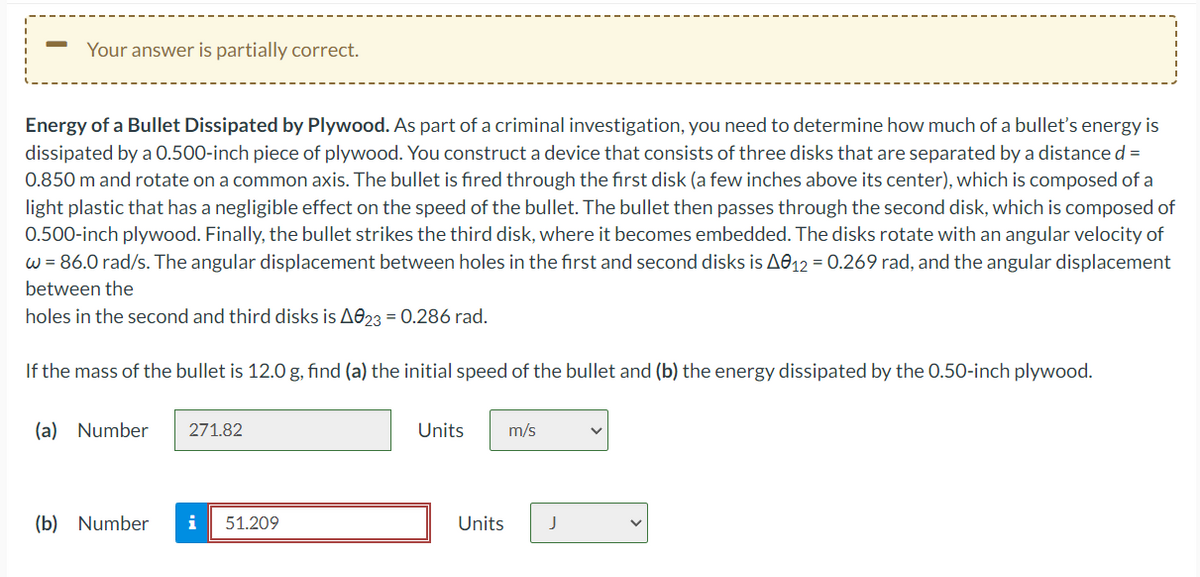Principles of Physics: A Calculus-Based Text
5th Edition
ISBN:9781133104261
Author:Raymond A. Serway, John W. Jewett
Publisher:Raymond A. Serway, John W. Jewett
Chapter10: Rotational Motion
Section: Chapter Questions
Problem 44P: Consider two objects with m1 m2 connected by a light string that passes over a pulley having a...
Related questions
Question

Transcribed Image Text:Your answer is partially correct.
Energy of a Bullet Dissipated by Plywood. As part of a criminal investigation, you need to determine how much of a bullet's energy is
dissipated by a 0.500-inch piece of plywood. You construct a device that consists of three disks that are separated by a distance d =
0.850 m and rotate on a common axis. The bullet is fired through the first disk (a few inches above its center), which is composed of a
light plastic that has a negligible effect on the speed of the bullet. The bullet then passes through the second disk, which is composed of
0.500-inch plywood. Finally, the bullet strikes the third disk, where it becomes embedded. The disks rotate with an angular velocity of
w = 86.0 rad/s. The angular displacement between holes in the first and second disks is A012 = 0.269 rad, and the angular displacement
between the
holes in the second and third disks is A023 = 0.286 rad.
If the mass of the bullet is 12.0 g, find (a) the initial speed of the bullet and (b) the energy dissipated by the 0.50-inch plywood.
(a) Number
271.82
(b) Number i 51.209
Units
m/s
Units J
V
Expert Solution
This question has been solved!
Explore an expertly crafted, step-by-step solution for a thorough understanding of key concepts.
This is a popular solution!
Trending now
This is a popular solution!
Step by step
Solved in 2 steps with 2 images

Knowledge Booster
Learn more about
Need a deep-dive on the concept behind this application? Look no further. Learn more about this topic, physics and related others by exploring similar questions and additional content below.Recommended textbooks for you

Principles of Physics: A Calculus-Based Text
Physics
ISBN:
9781133104261
Author:
Raymond A. Serway, John W. Jewett
Publisher:
Cengage Learning

Physics for Scientists and Engineers with Modern …
Physics
ISBN:
9781337553292
Author:
Raymond A. Serway, John W. Jewett
Publisher:
Cengage Learning

Physics for Scientists and Engineers
Physics
ISBN:
9781337553278
Author:
Raymond A. Serway, John W. Jewett
Publisher:
Cengage Learning

Principles of Physics: A Calculus-Based Text
Physics
ISBN:
9781133104261
Author:
Raymond A. Serway, John W. Jewett
Publisher:
Cengage Learning

Physics for Scientists and Engineers with Modern …
Physics
ISBN:
9781337553292
Author:
Raymond A. Serway, John W. Jewett
Publisher:
Cengage Learning

Physics for Scientists and Engineers
Physics
ISBN:
9781337553278
Author:
Raymond A. Serway, John W. Jewett
Publisher:
Cengage Learning

Physics for Scientists and Engineers, Technology …
Physics
ISBN:
9781305116399
Author:
Raymond A. Serway, John W. Jewett
Publisher:
Cengage Learning

Physics for Scientists and Engineers: Foundations…
Physics
ISBN:
9781133939146
Author:
Katz, Debora M.
Publisher:
Cengage Learning

College Physics
Physics
ISBN:
9781938168000
Author:
Paul Peter Urone, Roger Hinrichs
Publisher:
OpenStax College